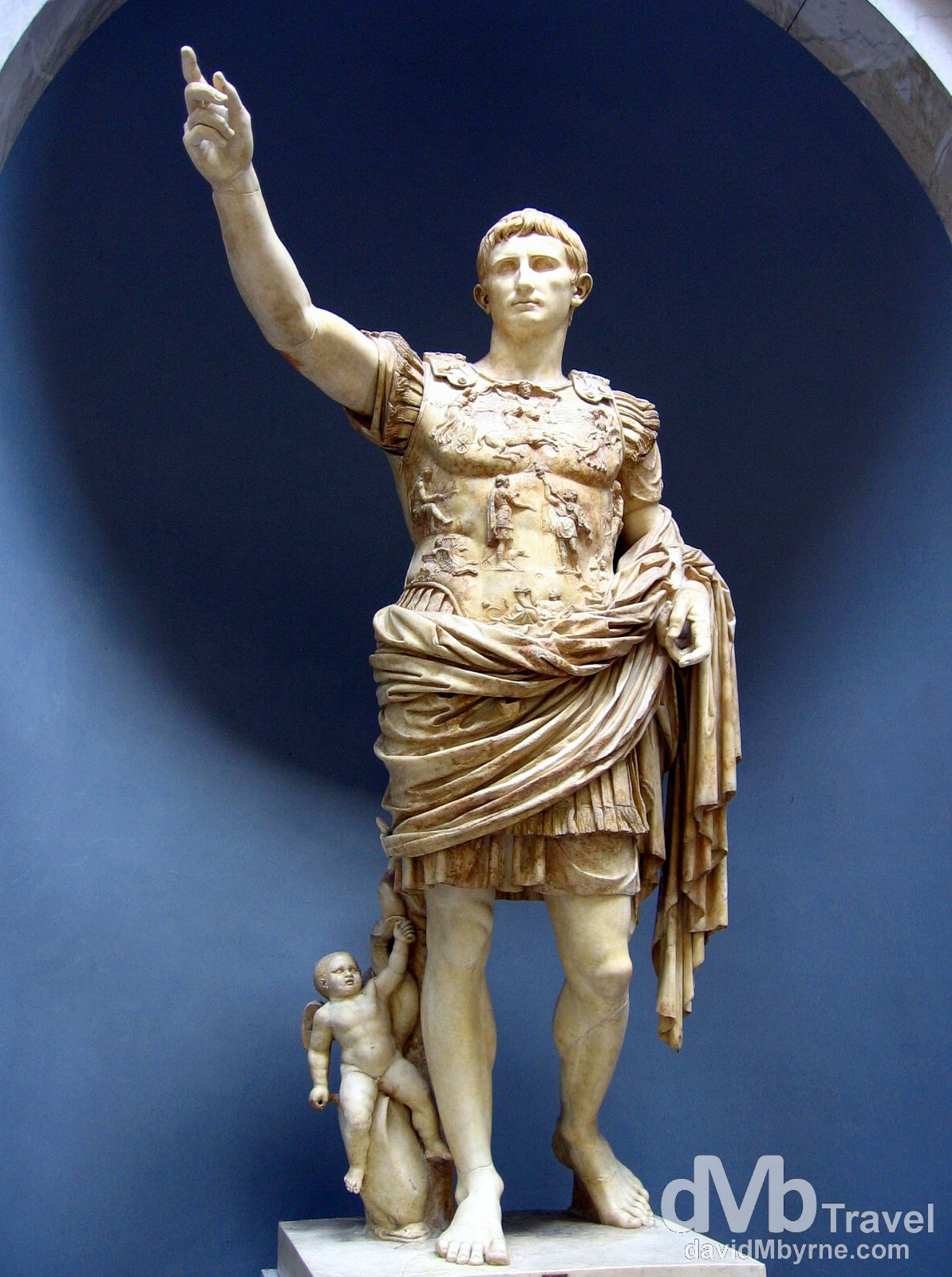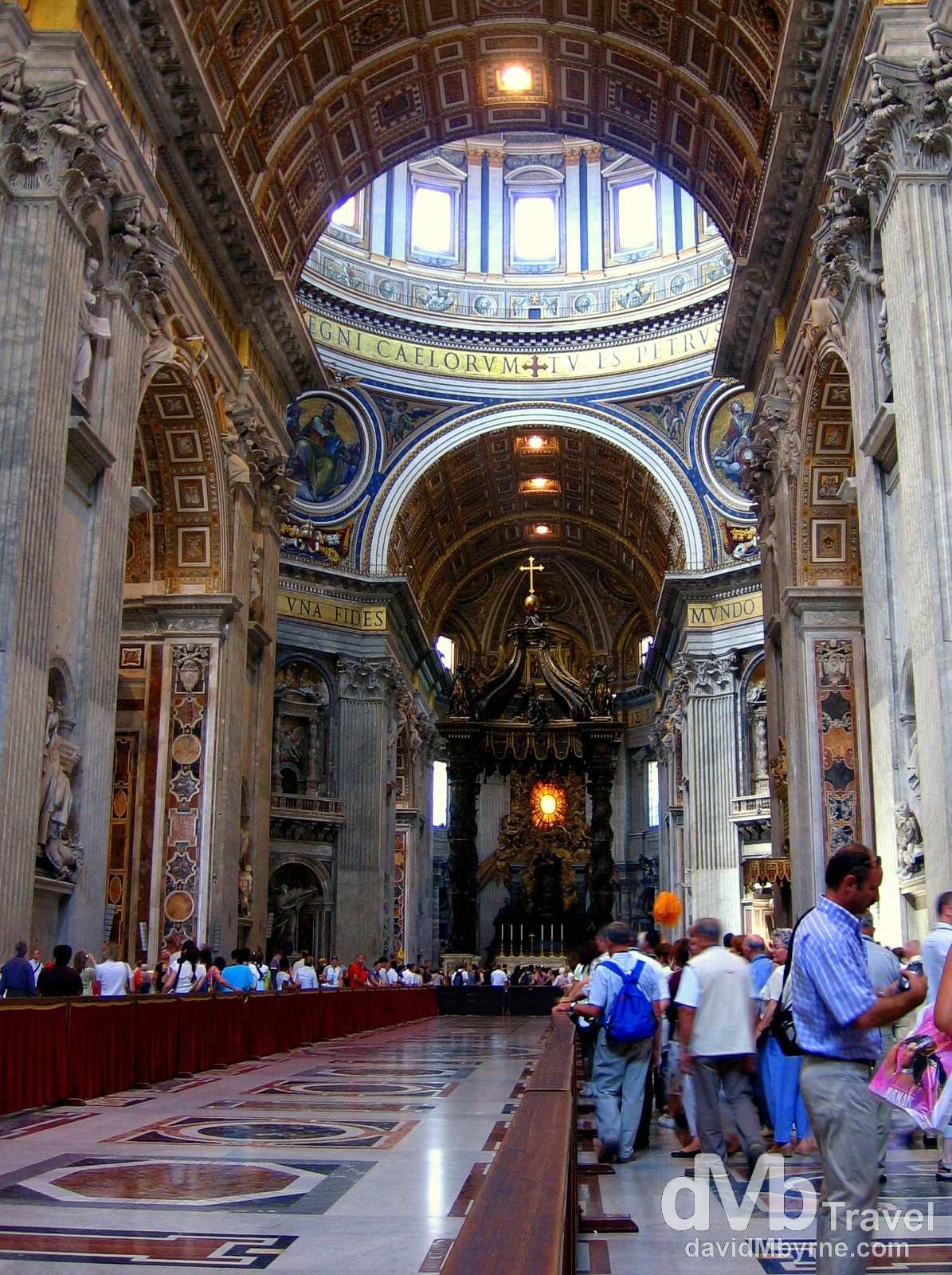Vatican City
A Sovereign City-State, The World’s Smallest Country & Home To The Most Compelling Museum Complex On Earth
Ceiling of the Sistine Chapel, Vatican City. September 3, 2007
Vatican City, officially Vatican City State, is a UNESCO World Heritage listed landlocked sovereign city-state whose territory consists of a walled enclave within the city of Rome, Italy. It achieved sovereignty from Italy & the wider city of Rome in 1929 when the then Fascist Italian leader Mussolini granted a request from Pope Pius XI who didn’t want the Vatican to be seen to have an allegiance with any one country (although when visiting you’ll never feel like you’ve left the city of Rome). It has a population of approximately 900 and boasts its own radio station, postal service and daily newspaper. At a mere 109 acres, it is the smallest independent nation in the world. But its diminutive size aside, it packs quite a punch with regard to must-see attractions, namely the stunning but exhaustive complex that is the Vatican Museums & St Peter’s Basilica, the greatest church in Christendom & the largest house of worship in the world.
– UNESCO commenting on Vatican City
Vatican Museums
The Vatican Museums are, simply put, the largest, richest, most compelling & perhaps most exhausting museum complex in the world. None other even come close. Over the years the various Popes have amassed an enormous collection of priceless booty and with so many of the Renaissance’s finest artists working for the Pontiff of the day it is not surprising that the result is a set of museums stuffed with enough exhibits to put most other European collections to shame. As the name suggests, the complex actually holds a series of museums on very diverse subjects: classical statuary, Renaissance painting, Etruscan relics, Egyptian artefacts etc. Not all of the totty is on display but even so, there’s still a lot to see – paintings, frescoes, statues, sculptures etc. – and most of what you do get to ogle at is rather pretty, very easy on the eye.

Inside a section of the extraordinary Vatican Museums, Vatican City. September 3rd, 2007.

The decoration and furnishings of the museum rooms themselves are splendid; most of them are painted, floor to ceiling in the most gorgeous and complex frescos. One of the more impressive rooms in the Vatican Museums is the Galleria delle Carte Geografiche (Gallery of Maps). A long room decorated in the late 16th century at the behest of Pope Gregory XIII, it show all of Italy, the major islands in the Mediterranean, the papal possessions in France, as well as the Siege of Malta, the Battle of Lepanto and large-scale maps of the maritime republics of Venice and Genoa. The ceiling frescoes illustrate scenes that took place in the area depicted in each adjacent map, all in astonishing and vivid detail. It’s nothing more than a passageway one walks through en route to other areas of the vast Vatican Museums but even so it’s still a highlight of a visit to this astonishing complex of museums. Galleria delle Carte Geografiche (Gallery of Maps), Vatican Museums, Vatican City. September 3rd, 2007.

A picture of probably the most famous extant representation of Augustus, the Roman statesman who established the Roman Empire and became emperor in 27 BC. The statue is housed in the airy Braccio Nuovo section of the Vatican Museums, built in the early 1800s to display classical statuary. Vatican Museums, Vatican City. September 3rd, 2007.

This, The Raphael Rooms, is the so-called runner-up in the battle for the Vatican Museum’s most popular attraction. The rooms formed the private apartments of Pope Julius II and when he moved in here he commissioned Raphael, one of the masters of the Renaissance, to redecorate them in a style more in tune with the times. Raphael died in 1520 before the scheme was fully complete but the two rooms that were painted by him stand as one of the highlights of the Renaissance. This is a picture taken in the Stanza della Segnatura, or Pope’s study (pictures were allowed in here, unlike in the neighbouring Sistine Chapel). The room was painted in the years 1508-11 when Raphael first came to Rome & the work on display here show the artist at the peak of his abilities. Of the four walls painted in here, this, The School of Athens, steals the show – it’s a representation of the triumph of scientific truth in which all the great minds from antiquity are represented. Stanza della Segnatura, Vatican Museums, Vatican City. September 3rd, 2007.

And so to the highlight of a visit of the Vatican Museums for most, the famous the Sistine Chapel. This is a picture taken from the rear of the chapel, looking towards to the altar, behind which is Michelangelo’s unmistakable fresco (wall painting) of The Last Judgement. I’m probably going straight to hell for capturing pictures in here (photography is prohibited in the Sistine Chapel) but I take solace in the fact that I wasn’t the only sinner in here capturing their astonishing surroundings. The chapel is a huge barn-like structure that serves as the Pope’s official private chapel and the scene of the conclaves of cardinals for the election of each new pontiff. The Sistine Chapel, Vatican City. September 3rd, 2007.
Michelangelo & The Sistine Chapel Frescoes
The Sistine Chapel’s paintings of the Last Judgement and the ceiling frescoes (titled Creation) are probably the most viewed paintings in the world – it’s estimated that on an average day about 15,000 people trudge through here to take a look. The walls of the Sistine Chapel were decorated by several prominent painters of the Renaissance – Pinturicchio, Perugino, Botticelli and Ghirlandaio. Recently restored, they would be studied very closely anywhere else. As it is they are entirely overshadowed by Michelangelo’s more famous ceiling frescoes, frescoes that were commissioned in 1508 by Pope Julius II, an avid collector and patron of the arts who summoned to Rome the best artists and architects of the day. Michelangelo was assigned the task of decorating the Sistine Chapel, with work commencing at the height of the Renaissance in 1508. Oddly enough, Michelangelo hadn’t wanted to do the work at all – he considered himself a sculptor, not a painter, and was more eager to get on with carving Julius II’s tomb rather than painting the ceiling, something he regarded as a chore. Regardless, he followed through with the task & devoted 4 years of his life to painting, single-handedly, the ceiling with scenes from the Old Testament.

Detail of a section of the Creation fresco on the ceiling of the Sistine Chapel with its most famous detail, The Creaton of Adam, seen in the centre of the picture. The image of the near-touching hands of God and Adam – illustrating the Biblical creation narrative from the Book of Genesis in which God breathes life into Adam, the first man – has become an iconic image of humanity and has been reproduced in countless imitations and parodies – it, along with Leonardo da Vinci’s Last Supper fresco in the Convent of Santa Maria delle Grazie, Milan, are said to be the most replicated religious paintings of all time. Frescoes on the ceiling of the Sistine Chapel, Vatican City. September 3rd, 2007.

A closer look at The Sistine Chapel’s The Last Judgement fresco. Also painted by Michelangelo although more than twenty years after he painted the ceiling frescos. Just like the ceiling frescos, Michelangelo wasn’t especially keen to work on this project either but Pope Paul III, an old acquaintance, was eager to complete the decoration of the chapel and managed to convince him. The painting took five years, again single-handed, and is probably the most inspired and homogeneous large-scale painting you’re ever likely to see. The centre is occupied by Christ, turning angrily as he gestures the condemned to the underworld. St. Peter, carrying his gold and silver keys, looks on in astonishment (the hunched over man with the grey beard to Christ’s left), while Mary (directly to the right of Christ, blue dress) averts her eyes from the scene. Below Christ a group of angels blasts their trumpets to summon the dead from their sleep. On the left the dead awaken from their graves, tombs and sarcophagi and are levitating into the heavens or being pulled by ropes and the napes of their necks by angels who take them before Christ. At the bottom right, Charon, keeper of the underworld, swings his oar at the damned souls as they fall off the boat into the waiting gates of hell. The Sistine Chapel, Vatican City. September 3rd, 2007.

A picture of activity on the iconic Bramante Staircase in the Vatican Museums, a double helix staircase located at the end of the museum visit. Most people are nicely exhausted by the time they reach this point on the Vatican Museums one-way circuit. Vatican Museums, Vatican City. September 3rd, 2007.
St. Peter’s || Square & Basilica

At the centre of Vatican City is the 17th century (built from 1665-1667) St. Peter’s Square fronting St. Peter’s Basilica. The square is considered a masterpiece by its designer Gian Lorenzo Bernini who, under the direction of Pope Alexander VII, was asked to design an appropriate forecourt “so that the greatest number of people could see the Pope give his blessing, either from the middle of the façade of the church or from a window in the Vatican Palace”. The square’s primary resident is obviously St. Peter’s Basilica but it also houses an obelisk which was brought to Rome by Caligula in 36 AD. It was moved here in 1586 when Pope Sixtus V ordered that it be erected in front of the basilica, a task that took four months to complete and was apparently done in silence on pain of death. St. Peter’s Square, Vatican City (![]() ). September 1st, 2007.
). September 1st, 2007.

The interior of St. Peter’s Basilica. It’s believed that St. Peter was buried in a pagan cemetery on the Vatican hill, giving rise to the building of a basilica in the 4th century to venerate his name. It was redesigned to its present form in 1503 and was worked on by the greatest Italian architects of the time. The largest church building in Christianity, it covers an area of 5.7 acres, has a capacity of over 60,000 and houses many treasures. Although the basilica is not the Pope’s official seat as Bishop of Rome, it is most certainly his principal church as most Papal ceremonies take place here due to its size, proximity to the Papal residence and location within the Vatican City walls. St. Peter’s Basilica, The Vatican City. September 1st, 2007.

Definitely the the most famous feature of St. Peters Basilica is its dome. Measuring an impressive 42 metres in diameter means it one of the largest domes in the world – soaring 136 metres above the floor means it is the tallest dome in the world. There is always debate as to who designed it but kudos generally goes to Michelangelo who was a mere 26 years dead when the dome was finally completed in 1590. Also seen here is the top section of the basilica’s High Altar which rises above the supposed tomb of St. Peter. St. Peter’s Basilica, The Vatican City. September 1st, 2007.

Statues adorning the facade of St. Peter’s Basilica, Vatican City. September 1st, 2007.
